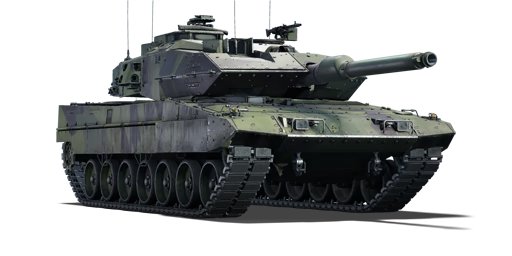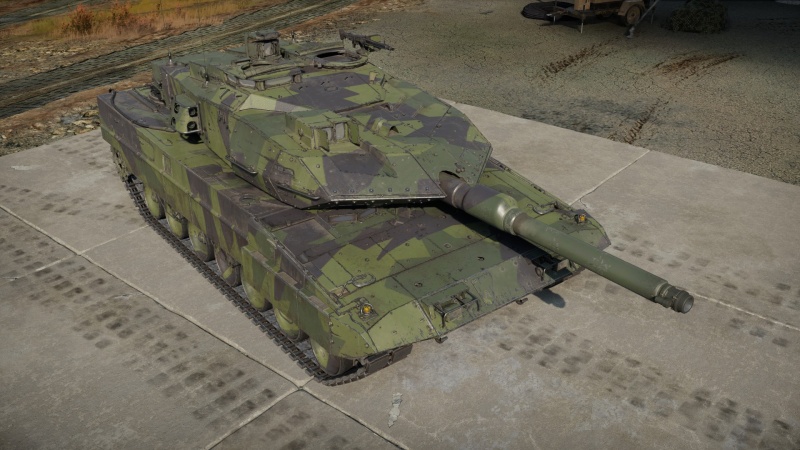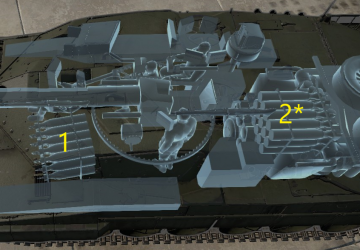Strv 122A
| This page is about the Swedish medium tank Strv 122A. For other versions, see Leopard 2 (Family). |
Contents
Description
The Stridsvagn 122A is the Swedish first subvariant for the Leopard 2A5, which is the sixth variant of the Leopard 2 main battle tank family. The Stridsvagn 122A is distinguished from the Leopard 2A5 largely by the French GALIX smoke dispensers, different storage bins, and thicker crew hatches. Everything else remains the same as on standard Leopard 2A5. The Leopard 2A5 (launched in mid-1998) differs from previous variants in appearance due to the addition of wedge-shaped spaced add-on armour over the entire front as well as the forward sides of the turret. This wedge-shaped space add-on armour is designed to deflect and erode kinetic-energy penetrators as well as neutralize a hollow charge before it reaches the base armour. The shot-trap effect was investigated and avoided as a result of the first layer, which does not deflect penetrators into the hull, as well as angle calculations and the material utilized for the outer layer. As a result, the gun mantlet had been altered to accommodate the new wedge-shaped spaced add-on armour. In addition, the complete composite armour composition has been altered and improved. Spall liners were fitted in the crew compartment to prevent fragmentation, and the frontal area of the side skirts was upgraded and fortified. The turret traverse and systems were completely electric to decrease weight and simplify maintenance and reliability. The tank commander's vision was placed beyond the hatch, and thermal imaging equipment was fitted separately. The gunner's sight was also moved to the turret roof (earlier versions had it incorporated into the front turret armour cavity). The driver's hatch has been modified as well. The entire gun brake system was updated because this type was scheduled to be upgraded to the new 120 mm Rheinmetall L/55 tank gun in the future Leopard 2A6 variant.
Introduced in Update 1.97 "Viking Fury", the Stridsvagn 122A variant provides higher turret protection than the preceding Stridsvagn 121 variant due to the addition of wedge-shaped spaced add-on armour covering the frontal area and forward flanks of the turret. Even though it is a spaced add-on armour, the characteristic wedge-shaped design effectively disrupts and reduces the energy of incoming enemy tank ammunition rounds, resulting in significant armour penetration reduction. The tank layouts are identical to the Stridsvagn 121, however, crew positions alter slightly. The tank commander's sight has been significantly enhanced, giving him an independent sight equipped with thermal imaging equipment, which offers hunter-killer capabilities.
General info
Survivability and armour
The outward of Strv 122A looks pretty much like Germany's Leopard 2A5. The most significant difference is the external steel plates on the turret roof which cover the 140 mm thick of composite armour around the cupolas. This design enhances the protection of the turret roof from most HE shells and some top-attack missiles with low penetration. The materials that the Strv 122A uses on side skirts and applique armour on the hull front are also better than Leopard 2A5. The Strv 122A has a decent frontal turret and upper glacis protection that are immune to most APFSDS from the top-tier MBTs.
However, the Strv 122A's lower glacis is quite weak and huge compared to most top-tier MBTs. The penetration from the left part of the lower glacis is likely to detonate the huge ammo rack, and the one from the right part of the lower glacis is likely to disable the driver, gunner and commander in one shot. Its bottom part of the gun mantlet is also a weak point for most kinetic shells with more than 450 mm penetration. The front of the turret roof is not covered by the composite armour, and it is too thin to neutralize overpressure impact when the raised frontal glacis on the turret catches the large-calibre HE shells. The wedge-shaped spaced add-on armour at the turret cheeks can be torn down by some artillery bombardments and non-lethal bomb strikes.
Armour type:
- Rolled homogeneous armour (sides, back and roof of hull, back and roof of turret, turret ring, underbody, commander optics, driver cupola)
- High hardness rolled armour (hull front, front and sides of turret, side skirts)
- Structural steel (applique armour on turret roof)
- Composite screen (turret cupolas, frontal part of side skirts, applique armour on hull front, external armour on front and sides of turret)
- External composite armour with NERA elements (gun mantlet)
- Cast homogeneous armour (upper front of turret)
| Armour | Front (Slope angle) | Sides | Rear | Roof |
|---|---|---|---|---|
| Hull | 35 + 45** mm (81°) Upper glacis 35 + 100** mm (53°) Upper junction of glacises 45 + 100** mm (54°) Lower junction of glacises 40 mm (51°) Lower glacis |
10 + 50** mm Top front 10 mm (5°) Top rear 35 + 100** mm Bottom front 35 + 10 mm Bottom middle 20 + 10 mm Bottom rear |
20 mm (11°) Top 20 mm (16°) Bottom |
20 mm 10 mm Engine vents |
| Turret | 35 mm (40°) + 80** mm (60°) Cheeks 650 mm (18°) + 80** mm (60°) Sides of gun mantlet 400 mm (0°) + 80** mm (63°) Top of gun mantlet 400 mm (0, 73°) Bottom of gun mantlet |
35 mm (0°) + 80** mm (22°) Front 15 mm Rear |
25 + 10 mm | 40 + 20 mm Front 40 mm (82°) + 10 mm (74°) Frontal glacis 20 + 14 mm Around the cupolas 20 mm Rear |
| Cupola | 150 mm (0°) + 10 mm (74°) | 45 mm (0°) + 10 mm (56°) | 10 mm | 60** + 20 mm |
** Composite screens
| Composite armour | Frontal effective protection | Sides |
|---|---|---|
| Hull | Upper glacis: 600-1000 mm Kinetic / 800-1200 mm Chemical Lower glacis: 150-500 mm Kinetic / 200-800 mm Chemical |
Frontal part of top: 220-260 mm Kinetic / 540-600 mm Chemical |
| Turret | Cheeks: 800-1000 mm Kinetic / 1300-1400 mm Chemical Sides of gun mantlet: 600-800 mm Kinetic / 600-1000 mm Chemical Top of gun mantlet: 300-600 mm Kinetic / 500-900 mm Chemical Bottom of gun mantlet: 300-400 mm Kinetic / 300-600 mm Chemical |
Front: 250-350 mm Kinetic / 250-350 mm Chemical Rear: 60-70 mm Kinetic / 80-100 mm Chemical |
Notes:
- Suspension wheels and tracks are 20 mm thick, and the underbody is 20 mm thick.
- There is a 8 mm thick of internal RHA screen that separates the crew compartment from the engine. The two exterior fuel tanks at frontal part of hull sides are separated from the crew compartment by two 35 mm thick of internal RHA screens.
- The ammo rack in the turret is separated by a 35 mm thick of internal RHA screen.
- There are few 10 mm thick of attached tracks mounted on the rear of turret. The left side of turret rear is attached with a 20 mm thick of track.
- The wedge-shaped spaced add-on armour at the turret cheeks is 80 mm thick and can be torn down.
- There is 140 mm thick of roof composite armour around two turret cupolas, and several 10 and 20 mm thick of structural steel plates cover the composite armour inside.
- The smoke dispensers are protected by a RHA shell.
- There are several plates of spall liner at the frontal hull sides, top of turret, and around the hull ammo rack.
Mobility
The Strv 122A is an agile and fast MBT. It has average speed of ~50 km/h on any terrain and can reach maximum speed of 69 km/h within a dozen of seconds. Although it loses lots of speed when making a turn, it has a brilliant reverse speed of 31 km/h that only needs 5 seconds to reach. Those features and its good turning speed make the Strv 122A adapt to any terrain.
| Game Mode | Max Speed (km/h) | Weight (tons) | Engine power (horsepower) | Power-to-weight ratio (hp/ton) | |||
|---|---|---|---|---|---|---|---|
| Forward | Reverse | Stock | Upgraded | Stock | Upgraded | ||
| Arcade | 76 | 35 | 62.5 | 2,032 | 2,862 | 32.51 | 45.79 |
| Realistic | 69 | 31 | 1,327 | 1,500 | 21.23 | 24 | |
Modifications and economy
Armaments
Main armament
The 120 mm kan Strv 122 is a Swedish license-produced version of the Rheinmetall L/44, and has access to slpprj m/95 APFSDS rounds. However, players who have not unlocked it yet, or who cannot afford the cost of said ammunition on an already exorbitantly expensive tank to repair, will be treated to the DM23 round, which, whilst adequate for most targets, is less reliable.
The gun handling is excellent, featuring a fast turret traverse and fast gun elevation akin to most of its contemporaries, such as the M1A2 and Leopard 2A5. The reload is also comparable to the M1A2 and 2A5, being able to go down to 6.0 s. This is slower than other MBTs such as the Type 90 (B) and Challenger 2 (2F), and as fast as the Leclerc, which benefits from an autoloader. Its depression is -9°, which is good enough to most hilly maps.
| 120 mm kan Strv 122 | Turret rotation speed (°/s) | Reloading rate (seconds) | |||||||||||
|---|---|---|---|---|---|---|---|---|---|---|---|---|---|
| Mode | Capacity | Vertical | Horizontal | Stabilizer | Stock | Upgraded | Full | Expert | Aced | Stock | Full | Expert | Aced |
| Arcade | 42 | -9°/+20° | ±180° | Two-plane | 38.1 | 52.7 | 64.0 | 70.8 | 75.3 | 7.80 | 6.90 | 6.36 | 6.00 |
| Realistic | 23.8 | 28.0 | 34.0 | 37.6 | 40.0 | ||||||||
Ammunition
| Penetration statistics | |||||||
|---|---|---|---|---|---|---|---|
| Ammunition | Type of warhead |
Penetration @ 0° Angle of Attack (mm) | |||||
| 10 m | 100 m | 500 m | 1,000 m | 1,500 m | 2,000 m | ||
| DM23 | APFSDS | 410 | 408 | 401 | 393 | 384 | 376 |
| DM33 | APFSDS | 481 | 478 | 470 | 461 | 450 | 440 |
| slsgr m/95 | HE | 36 | 36 | 36 | 36 | 36 | 36 |
| slpprj m/95 | APFSDS | 589 | 586 | 577 | 565 | 553 | 541 |
| Shell details | ||||||||||||
|---|---|---|---|---|---|---|---|---|---|---|---|---|
| Ammunition | Type of warhead |
Velocity (m/s) |
Projectile mass (kg) |
Fuse delay (m) |
Fuse sensitivity (mm) |
Explosive mass (TNT equivalent) (kg) |
Ricochet | |||||
| 0% | 50% | 100% | ||||||||||
| DM23 | APFSDS | 1,640 | 4.3 | - | - | - | 78° | 80° | 81° | |||
| DM33 | APFSDS | 1,640 | 4.3 | - | - | - | 78° | 80° | 81° | |||
| slsgr m/95 | HE | 736 | 17.5 | 0 | 0.1 | 3.54 | 79° | 80° | 81° | |||
| slpprj m/95 | APFSDS | 1,705 | 5.6 | - | - | - | 78° | 80° | 81° | |||
Ammo racks
| Full ammo |
1st rack empty |
2nd rack empty |
Visual discrepancy |
|---|---|---|---|
| 42 | 16 (+26) | 1 (+41) | No |
Optics and night vision
| Strv 122A Optics | ||||||
|---|---|---|---|---|---|---|
| Type of optic | Magnification | Night Vision Devices | ||||
| Image Intensifier | Thermal Imager Resolution |
Notes | ||||
| Resolution | Light Mult | Noise Level | ||||
| Gunner's Sight | X4.0 - X12 | - | - | - | 500 x 300 | Thermal imager unlocked by "NVD" modification (tier 3) |
| Commander's View | X6 | - | - | - | 800 x 600 | Thermal imager unlocked by "NVD" modification (tier 3) |
| Driver's View | X1 | 800 x 600 | 5.0 | High | Not Fitted | Image intensifier unlocked by "NVD" modification (tier 3) |
Machine guns
The Strv 122 possesses a coaxial and a pintle-mounted 7.62 mm machine gun. Whilst ineffective against armour, they are able to deal with bushes, and lucky shots against aircraft may set their engine ablaze or hit their pilot.
| 7.62 mm ksp 94 | ||||
|---|---|---|---|---|
| Mount | Capacity (Belt) | Fire rate | Vertical | Horizontal |
| Coaxial | 5,000 (200) | 1,200 | N/A | N/A |
| Pintle | 2,000 (200) | 1,200 | -10°/+75° | ±180° |
Usage in battles
Playing like the average Main Battle Tank should suffice. Compared to most tanks, the frontal armour and turret are better protected, meaning the tank can be played more aggressively. Hiding the lower mantlet is still required to avoid opponents exploiting a weak point.
Pros and cons
Pros:
- A very well armoured MBT with even fewer weak spots (UFP)
- There is a thick layer composite armour covering the middle of turret roof
- Good speed and manoeuvrability
- Equipped with high-penetrating APFSDS shells and powerful HE shells
- Gen 2 thermal sights for the commander, with a well elevated commander view
Cons:
- Lower frontal plate is weak and relatively huge. Most penetrations from here are deadly
- Turret ring is the main target for enemy tanks
- The frontal turret roof out of the coverage of raised composite armour is too thin to neutralize overpressure impact when catching missiles or HE shells
History
Describe the history of the creation and combat usage of the vehicle in more detail than in the introduction. If the historical reference turns out to be too long, take it to a separate article, taking a link to the article about the vehicle and adding a block "/History" (example: https://wiki.warthunder.com/(Vehicle-name)/History) and add a link to it here using the main template. Be sure to reference text and sources by using <ref></ref>, as well as adding them at the end of the article with <references />. This section may also include the vehicle's dev blog entry (if applicable) and the in-game encyclopedia description (under === In-game description ===, also if applicable).
Media
- Skins
- Videos
See also
Links to the articles on the War Thunder Wiki that you think will be useful for the reader, for example:
- reference to the series of the vehicles;
- links to approximate analogues of other nations and research trees.
External links
Paste links to sources and external resources, such as:
- topic on the official game forum;
- other literature.
| BAE Systems AB | |
|---|---|
| Light Tanks | |
| CV90 | Strf 9040B · Strf 9040C · Strf 9040 BILL · CV 90105 · CV 90120 |
| MBTs | |
| Strv 122 | Strv 122A · Strv 122B PLSS · Strv 122B+ |
| SPAA | |
| CV90 | Lvkv 9040C |
| See Also | AB Bofors · Hägglund & Söner · KMW |
| Sweden medium tanks | |
|---|---|
| Strv m/42 | Lago I · Strv m/42 EH · Ikv 73 · Strv m/42 DT · Pvkv IV |
| Centurion derivatives | Strv 81 · Strv 81 (RB 52) · Strv 101 · Strv 104 · Strv 105 |
| Strv 103 | Strv 103-0 · Strv 103A · Strv 103С |
| Strv 121/122 | Strv 121 · Christian II · Strv 122A · Strv 122B PLSS · Strv 122B+ |
| Other | Sherman III/IV · T 80 U |
| Finland | |
| WWII | ▄T-28 · ▄T-34 · ▄Pz.IV · ▄T-34-85 |
| Post War | ▄Comet I · ▄Charioteer Mk VII · ▄T-54 · ▄T-55M · ▄T-72M1 · ▄Leopard 2A4 · ▄Leopard 2A6 |
| Norway | Leopard 1A5NO2 |






